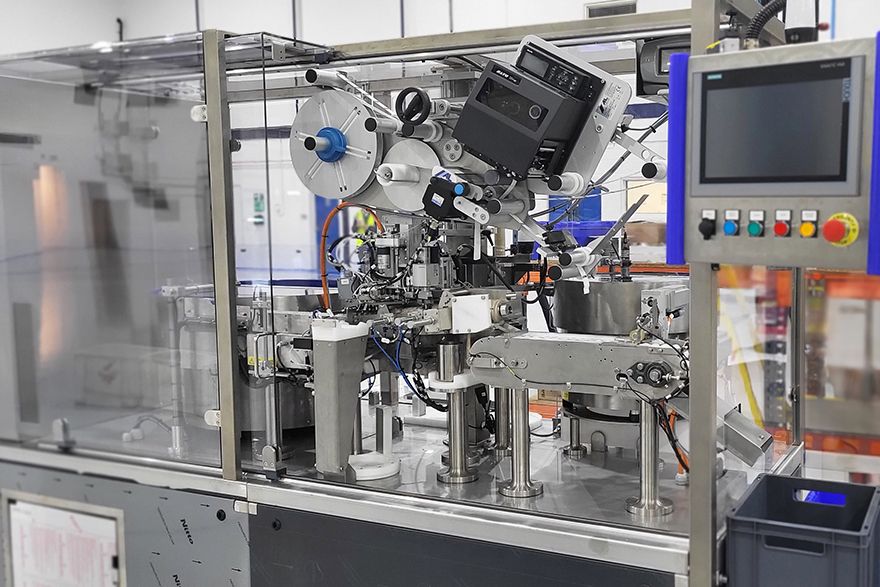 The high-speed vial filling, capping and labelling line designed by QM Systems
The high-speed vial filling, capping and labelling line designed by QM SystemsIndustrial automation specialist
Festo and systems integrator
QM Systems have collaborated on a new automated laboratory system that fills, caps and labels test vials at speeds of up to 3,000 vials per hour.
The need for rapid and accurate mass testing was a key imperative during the Covid-19 pandemic and the ability to automate the dosing process offers many opportunities in the post-pandemic world. Applications range from disease detection and medical diagnostics to cosmetics and biotech.
Festo and QM Systems have a longstanding relationship, but the increase in demand for automation in life sciences and lifetech within the last few years has prompted an even closer collaboration.
Russell Lotinga, Festo business development manager, said: “We were approached by a customer who had a clear and immediate requirement for a high throughput filling system, but Festo are not machine builders. We took the challenge to QM Systems because they specialise in the development of automated systems, tailored to suit customers’ requirements. Combined with our expertise regarding the automation components required to achieve the complex filling and handling requirements, we were able to develop an optimum solution for this customer.”
The original challenge was to develop a machine for respiratory testing that could automatically fill vials to different levels accurately, repeatedly and at speed, while also ensuring traceability back to individual patients.
QM Systems designed a high-speed vial filling, capping and labelling line based on a
Siemens control. The system uses two bowl feeders — one for the vials, one for caps — to introduce the parts into the machine. The Festo handling system lifts each vial out and lines it up vertically before presenting it to the dosing head for the liquid to be added. A cap is then applied, using torque monitoring to ensure the lid is fitted correctly. The filled and sealed vial is then oriented horizontally and presented via a pocket conveyor for labelling. A serially coded label ensures each vial can be linked to a specific patient.
 Pictured right: the automated filling line incorporates Festo’s VTOE dispensing heads and VAEM high-speed valve control module
Pictured right: the automated filling line incorporates Festo’s VTOE dispensing heads and VAEM high-speed valve control moduleKristian Richardson, commercial director of QM Systems, said: “The challenge with this project was the fine tolerances, tight accuracies, variable dispense volumes and high throughputs. To achieve a robust solution the commissioning phase was critical but designing in adaptability was the key to allow us tweaking positions during setup. Festo’s comprehensive range of automation components, combined with their considerable expertise in specifying complex handling systems, enabled us to develop the best solution.”
For optimum accuracy, the automated filling line incorporates Festo’s VTOE dispensing head and VAEM valve control module. With eight dispensing needles, the VTOE enables precision dispensing of various liquids and filling volumes. Very specific dosing quantities can be achieved thanks to the flexible and reproducible pressure and opening times. The VAEM valve control module makes precise switching of the solenoid valves simple and allows up to eight channels to be parameterised individually. A time resolution of only 0.2ms and control of the valves via current — not voltage — ensure high precision.
Capping tolerances are controlled by Festo’s EHMD rotary gripping module. Its unique Z compensating module automatically adjusts to the thread pitches of the vials. Various other Festo servo drives and controllers, coupled with pneumatic actuators, facilitate the correct orientation of the vials during dosing and then rotate them horizontally to allow individual labels to be applied.
The new automated dosing system can deliver variable fill volumes from less than 10 microlitres to bulk dispensing of much higher volumes. It processes an impressive 3,000 vials per hr and achieves a repeatability of +/-0.5% with a fill volume of 50 to 1,500µl.
Mr Richardson concluded: “This particular automated system was designed to handle one vial and one lid, with variable dosing levels. However, the automation principles involved can be readily expanded and adapted to meet other customer requirements. It offers big advantages of improved speed and accuracy over previous handling systems and can be equally applied to bloods and other bodily fluids, as well as non-medical liquids dosing and testing.”